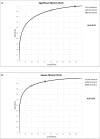Deciding on Interferon-Free Treatment for Chronic Hepatitis C: Updating Liver Stiffness Cut-Off Values to Maximize Benefit
- PMID: 27723770
- PMCID: PMC5056756
- DOI: 10.1371/journal.pone.0164452
Deciding on Interferon-Free Treatment for Chronic Hepatitis C: Updating Liver Stiffness Cut-Off Values to Maximize Benefit
Abstract
Introduction: In a perspective of economic constraints the prioritizing of patients to IFN-free regimens is mainly based on the determination of liver stiffness by transient elastography (TE). Being a continuous variable the interpretation of TE results requires the identification of cut-off values, to date set to maximize diagnostic accuracy even if such values should be better based on more helpful outcome prediction endpoints.
Aim: To define the TE cut-off values in different clinical scenarios, including new IFN-free regimens, and to balance the clinical benefits versus harms in treated and untreated patients.
Methods: We assessed the accuracy of TE in staging 728 consecutive HCV patients and the distribution of TE values in 1,001 blood donors. Ten experts quantified the expected harm/benefit ratio for 6 scenarios resulting from 2 stages of liver disease (F≥2 or F≥3) and 3 treatment regimens: PEGIFN+ribavirin, PEGIFN+RBV+first-generation protease inhibitor, and IFN-free regimens. The optimal TE cut-off values were identified using the Metz equation.
Results: The estimated mean expected harm/benefit ratio for IFN-free regimens was 1/8.3 in patients with F≥2 and 1/10 in those with F≥3. The resulting optimal cut-off values were respectively 4.5 kPa with sensitivity at 99% and specificity at 12%, and 6.8 kPa with sensitivity at 94% and specificity at 41%. These cut-off values are lower than those maximizing accuracy and allow to reduce the number of false negative results.
Conclusions: The optimal TE cut-off values to prioritize patients for IFN-free regimens, are sensibly lower than those used to maximize diagnostic accuracy.
Conflict of interest statement
The authors have declared that no competing interests exist.
Figures
Similar articles
-
The diagnostic accuracy of Fibroscan for cirrhosis is influenced by liver morphometry in HCV patients with a sustained virological response.J Hepatol. 2013 Aug;59(2):251-6. doi: 10.1016/j.jhep.2013.03.013. Epub 2013 Mar 23. J Hepatol. 2013. PMID: 23528378
-
Which are the cut-off values of 2D-Shear Wave Elastography (2D-SWE) liver stiffness measurements predicting different stages of liver fibrosis, considering Transient Elastography (TE) as the reference method?Eur J Radiol. 2014 Mar;83(3):e118-22. doi: 10.1016/j.ejrad.2013.12.011. Epub 2013 Dec 17. Eur J Radiol. 2014. PMID: 24380640
-
Acoustic radiation force impulse elastography as compared to transient elastography and liver biopsy in patients with chronic hepatopathies.Ultraschall Med. 2011 Jan;32 Suppl 1:S46-52. doi: 10.1055/s-0029-1245360. Epub 2010 Jul 5. Ultraschall Med. 2011. PMID: 20603783
-
Performance of a new elastographic method (ARFI technology) compared to unidimensional transient elastography in the noninvasive assessment of chronic hepatitis C. Preliminary results.J Gastrointestin Liver Dis. 2009 Sep;18(3):303-10. J Gastrointestin Liver Dis. 2009. PMID: 19795024
-
Comparison of three cut-offs to diagnose clinically significant portal hypertension by liver stiffness in chronic viral liver diseases: a meta-analysis.Eur Radiol. 2018 Dec;28(12):5221-5230. doi: 10.1007/s00330-018-5478-z. Epub 2018 Jun 1. Eur Radiol. 2018. PMID: 29858640
Cited by
-
Ultrasound/Elastography techniques, lipidomic and blood markers compared to Magnetic Resonance Imaging in non-alcoholic fatty liver disease adults.Int J Med Sci. 2019 Jan 1;16(1):75-83. doi: 10.7150/ijms.28044. eCollection 2019. Int J Med Sci. 2019. PMID: 30662331 Free PMC article. Clinical Trial.
-
Prioritization for interferon-free regimens and potential drug interactions of current direct-acting anti-hepatitis C agents in routine clinical practice.Ann Gastroenterol. 2017;30(5):542-549. doi: 10.20524/aog.2017.0170. Epub 2017 Jun 26. Ann Gastroenterol. 2017. PMID: 28845110 Free PMC article.
References
Publication types
MeSH terms
Substances
LinkOut - more resources
Full Text Sources
Other Literature Sources
Miscellaneous


